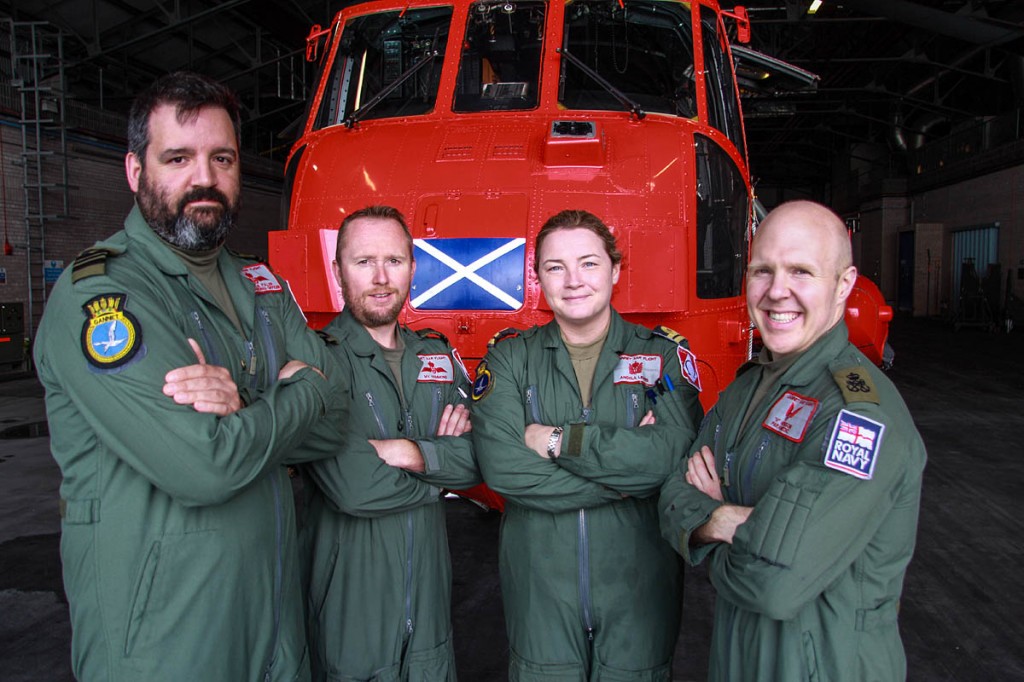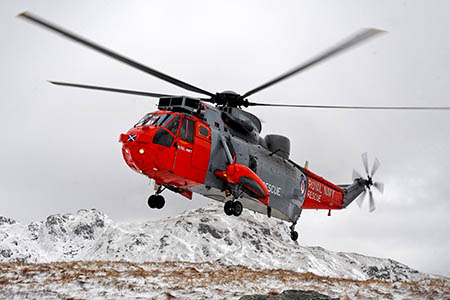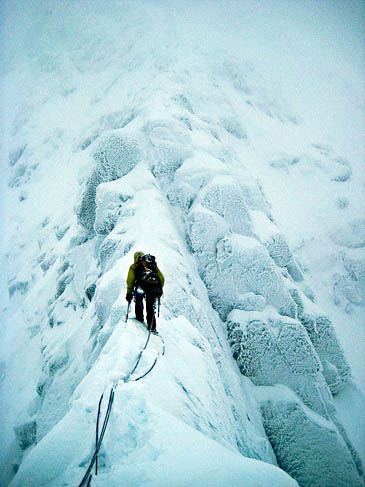
From left: Lieutenant Commander Charles Fuller, Lieutenant Merion Hammond, Lieutenant Angela Lewis and Petty Officer Aircrewman Mike Henson pose with their Sea King. Photo: Crown Copyright
The crew of a Royal Navy Sea King helicopter has been honoured for its heroic rescue of two climbers in blizzard conditions on Britain’s highest mountain.
The four members of the HMS Gannet search and rescue aircraft made six attempts to reach the pair on Tower Ridge on Ben Nevis.
The helicopter, piloted by Lieutenant Commander Charlie Fuller, was also asked to take part in three other missions within hours of the Ben Nevis rescue in January this year.
Lt Cdr Fuller, along with Lieutenant Merion Hammond, Lieutenant Angela Lewis and Petty Officer Aircrewman Mike Henson received the Prince Philip Helicopter Rescue Award in recognition of their outstanding determination, tenacity, courage, team-work and professionalism. Lt Cdr Fuller is the commanding officer at the Prestwick-based rescue centre, which is due to cease operations in January 2016 when a civilian service takes over.
The award is made for an act of outstanding courage or devotion to duty in the course of land or sea search and rescue operations.
A Royal Navy spokesperson described the rescue, which took place in some of Scotland’s worst winter weather of the season, on 17 January: “This was the third rescue for this crew in a 24-hour duty period.
“Previously, they had been tasked to a casualty on the Isle of Rothesay and a further casualty on the Isle of Mull, both needing flown to a Glasgow hospital.
“However, the third rescue was at 7pm and the weather had started to deteriorate markedly. At night, in the depths of the Scottish winter, they were forced to fly a low-level – under 500ft – radar transit from Prestwick to Fort William through continuous snowstorms and freezing temperatures that limited visibility to less than 300m then kept the aircraft at very low-level through the Western Isles.

The Royal Navy Sea King completed the rescue in some of last winter's worst conditions. Photo: Stuart Hill/MoD/Crown Copyright
“Ben Nevis was in cloud, with waves of heavy snow showers limiting visibility, strengthening to blizzard conditions in the valley where the climbers were, in the upper section of the mountain. With no moon and full cloud cover, night vision goggles were being severely tested and offered little assistance within the sharp valley of Ben Nevis.
“The climbers were in a precarious position at the far end of the valley that the MRT were unable to get to without hazardous and lengthy effort. With weather worsening, R177 [the HMS Gannet Sea King] attempted to fly into the valley without full references and not having visual with both sides.
“The visibility was reduced to zero in blizzards, requiring a blind valley turn to be flown and the Sea King was forced out. Undeterred, they tried to enter the valley again but had to fly another blind valley turn, unsighted of the valley sides.
“On finding a small gap in the cloud cover to the east of the scene, R177 tried to access the top of the mountain.
“Finding that the access to the top was prohibited as well, R177 commenced a spiralling descent back through the cloud discovering that further attempts into the valley were now impossible due to a series of heavy snow showers crossing the mountain.
“These showers lowered the visibility to less than 300m and the cloud base to below 500ft; with snow rapidly accumulating on the airframe, R177 was forced to land at Fort William MRT base.”
The spokesperson said that, towards midnight, the showers appeared to lessen and the crew took off again, only to find blizzards continued to block access and they were stood down to be available for further rescues while waiting for the weather to ease.
The crew returned to base in Ayrshire and was scheduled to take part in a further rescue to the Isle of Eigg.
The spokesperson said: “The weather on Ben Nevis refused to relent and R177 was sent back via another low-level transit in the same atrocious conditions as local police’s concern for the climbers grew.
“With first light still to come, little had changed: R177 again attempted entry to the valley before severe turbulence and loss of visibility forced them out while having to alternate from full power to auto-rotation. On the second attempt, they were able to position the aircraft close enough to the ridge to maintain contact, hover-taxiing below the ridgeline towards the climbers.
“Blizzard conditions, re-circulating snow and on the edge of the cloud layer in sub-zero temperatures, there were few visual clues to the aircraft’s side and none in front; if these were lost it’s highly likely that aircraft and crew would have been poorly placed to survive.”
The crew maintained the helicopter’s escape options for as long as possible until it was forced to commit to the ridge, 3,800ft up on the mountain’s North Face, to reach the climbers.
The spokesperson said: “Once in position, R177 held a perfect hover within feet of the rock face while wind continued to batter the aircraft and visual references faded and reappeared in turn as the snow showers mixed with snow from the ridgeline above. Reliant on voice marshalling from the observer, the pilot maintained their accurate position and to help reduce the aircraft’s downwash on the climbers.”
“The winchman now had to contend with the weather and the various bits of equipment the climbers had used to secure themselves. Rapidly done, the aircrewman and climbers were recovered onboard. R177 then had to launch and turn on instruments alone until clear of the mountain, landing at Fort William.
“In this duty period, R177 flew 9:50 hours, in the worst conditions of the Scottish winter, conducting three rescues and planned a fourth. Lt Cdr Fuller piloted numerous night transits in the most marginal of weather and a rescue in the treacherous conditions of Ben Nevis with no illumination to assist.
“He was most ably supported by Hammond constantly updating information from the left hand seat. Henson’s cool bravery in exiting the aircraft into such marginal conditions led to a textbook recovery of the climbers.
“Lewis’ leadership in constantly calculating the risks to herself and crew to rescue the climbers who were in significant danger was exemplary. R177, as a crew, demonstrated courage of continued attempts to get to the climbers and tenacity to try different ways to succeed until ultimately the climbers were rescued.
“All of which was completed over several hours of flying in the worst of Scottish winter’s weather. They demonstrated teamwork, drive and skill that honours their heritage as naval aviators and was in the best traditions of the Fleet Air Arm.”
Central Ayrshire MSP Dr Philippa Whitford, is also seeking an early day motion in the Scottish Parliament, asking the house to honour ‘the outstanding courage, team-work and professionalism’ of the crew
The climbers, who were described as well-equipped by Lochaber Mountain Rescue Team, survived their night on the mountain unscathed.
HMS Gannet’s Sea Kings are the busiest search and rescue team in the UK, covering much of western and southern Scotland, northern England and Northern Ireland.
In January, Coastguard Sikorsky S-92 helicopters will take over civilian search and rescue missions, operated by a subsidiary of US company Bristow. The aircraft will be based at a new site at Prestwick Airport in Ayrshire.
